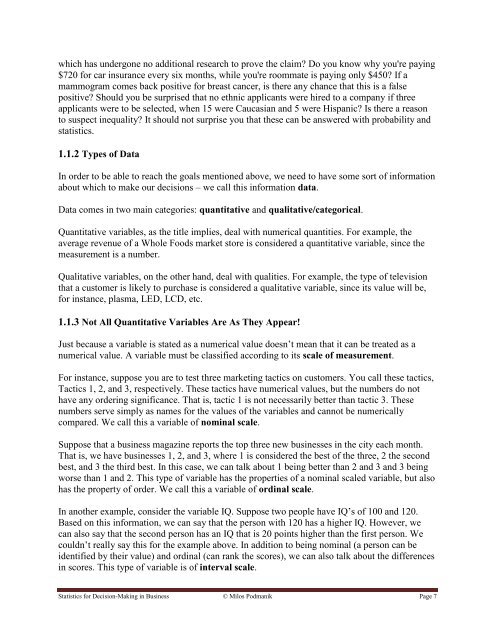Statistics for Decision- Making in Business - Maricopa Community ...
Statistics for Decision- Making in Business - Maricopa Community ...
Statistics for Decision- Making in Business - Maricopa Community ...
You also want an ePaper? Increase the reach of your titles
YUMPU automatically turns print PDFs into web optimized ePapers that Google loves.
which has undergone no additional research to prove the claim Do you know why you're pay<strong>in</strong>g<br />
$720 <strong>for</strong> car <strong>in</strong>surance every six months, while you're roommate is pay<strong>in</strong>g only $450 If a<br />
mammogram comes back positive <strong>for</strong> breast cancer, is there any chance that this is a false<br />
positive Should you be surprised that no ethnic applicants were hired to a company if three<br />
applicants were to be selected, when 15 were Caucasian and 5 were Hispanic Is there a reason<br />
to suspect <strong>in</strong>equality It should not surprise you that these can be answered with probability and<br />
statistics.<br />
1.1.2 Types of Data<br />
In order to be able to reach the goals mentioned above, we need to have some sort of <strong>in</strong><strong>for</strong>mation<br />
about which to make our decisions – we call this <strong>in</strong><strong>for</strong>mation data.<br />
Data comes <strong>in</strong> two ma<strong>in</strong> categories: quantitative and qualitative/categorical.<br />
Quantitative variables, as the title implies, deal with numerical quantities. For example, the<br />
average revenue of a Whole Foods market store is considered a quantitative variable, s<strong>in</strong>ce the<br />
measurement is a number.<br />
Qualitative variables, on the other hand, deal with qualities. For example, the type of television<br />
that a customer is likely to purchase is considered a qualitative variable, s<strong>in</strong>ce its value will be,<br />
<strong>for</strong> <strong>in</strong>stance, plasma, LED, LCD, etc.<br />
1.1.3 Not All Quantitative Variables Are As They Appear!<br />
Just because a variable is stated as a numerical value doesn‟t mean that it can be treated as a<br />
numerical value. A variable must be classified accord<strong>in</strong>g to its scale of measurement.<br />
For <strong>in</strong>stance, suppose you are to test three market<strong>in</strong>g tactics on customers. You call these tactics,<br />
Tactics 1, 2, and 3, respectively. These tactics have numerical values, but the numbers do not<br />
have any order<strong>in</strong>g significance. That is, tactic 1 is not necessarily better than tactic 3. These<br />
numbers serve simply as names <strong>for</strong> the values of the variables and cannot be numerically<br />
compared. We call this a variable of nom<strong>in</strong>al scale.<br />
Suppose that a bus<strong>in</strong>ess magaz<strong>in</strong>e reports the top three new bus<strong>in</strong>esses <strong>in</strong> the city each month.<br />
That is, we have bus<strong>in</strong>esses 1, 2, and 3, where 1 is considered the best of the three, 2 the second<br />
best, and 3 the third best. In this case, we can talk about 1 be<strong>in</strong>g better than 2 and 3 and 3 be<strong>in</strong>g<br />
worse than 1 and 2. This type of variable has the properties of a nom<strong>in</strong>al scaled variable, but also<br />
has the property of order. We call this a variable of ord<strong>in</strong>al scale.<br />
In another example, consider the variable IQ. Suppose two people have IQ‟s of 100 and 120.<br />
Based on this <strong>in</strong><strong>for</strong>mation, we can say that the person with 120 has a higher IQ. However, we<br />
can also say that the second person has an IQ that is 20 po<strong>in</strong>ts higher than the first person. We<br />
couldn‟t really say this <strong>for</strong> the example above. In addition to be<strong>in</strong>g nom<strong>in</strong>al (a person can be<br />
identified by their value) and ord<strong>in</strong>al (can rank the scores), we can also talk about the differences<br />
<strong>in</strong> scores. This type of variable is of <strong>in</strong>terval scale.<br />
<strong>Statistics</strong> <strong>for</strong> <strong>Decision</strong>-<strong>Mak<strong>in</strong>g</strong> <strong>in</strong> Bus<strong>in</strong>ess © Milos Podmanik Page 7
















